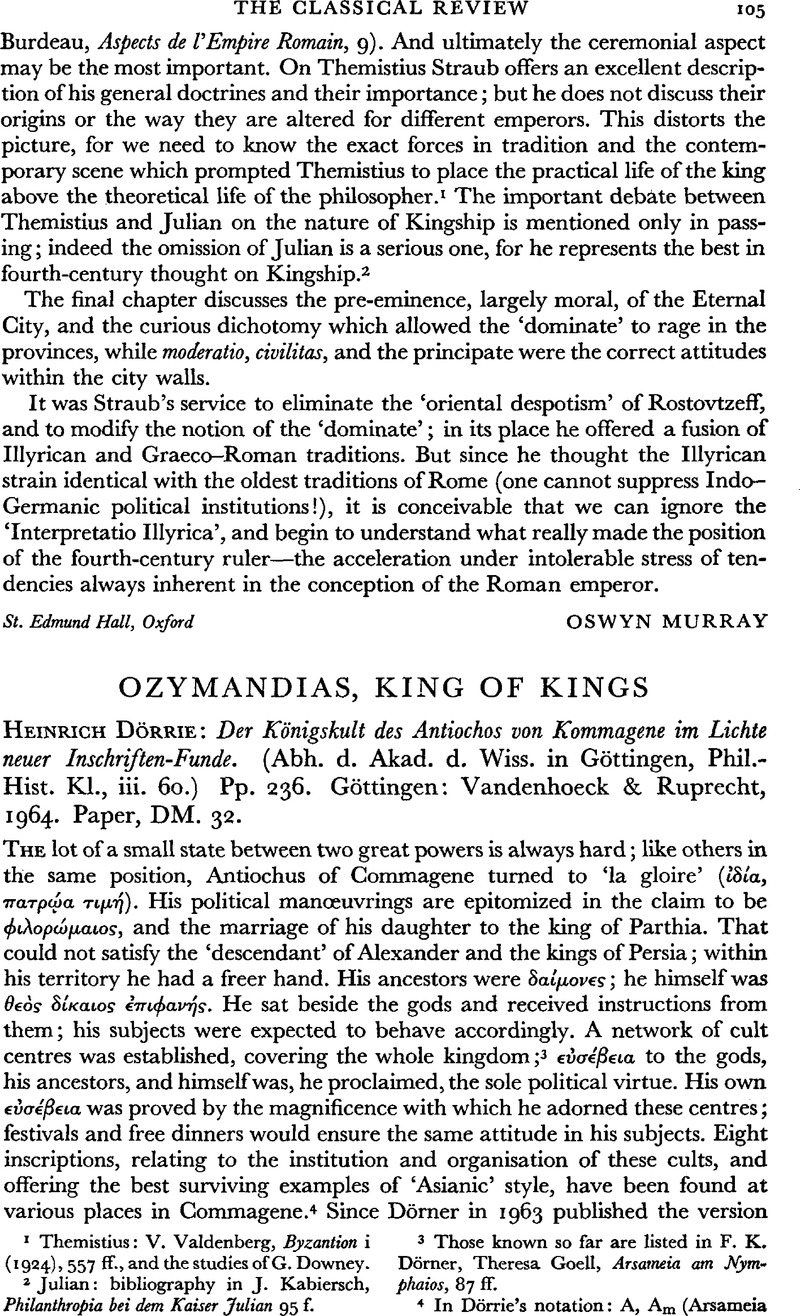No CrossRef data available.
Published online by Cambridge University Press: 27 February 2009

page 105 note 3 Those known so far are listed in F. K. Dörner, Theresa Goell, Arsameia am Nymphaios, 87 ff.
page 105 note 4 In Dörrie's notation: A, Am (Arsameia on Nymphaios), G (Arsameia on Euphrates), N, P (Nemrud Dagh), Sx, Sy, Sz (environs of Samosata).
page 106 note 1 True, Dörner in 1938 approved Puchstein's account of Cols, i–v (Forschungen in Kommagene, 23; cf. Dörrie p. 25), but that was before the discovery of A; in Arsameia, 40 ff., 85, he has introduced a number of improvements, and a full recension in the light of A seems essential.
page 106 note 2 It does in fact appear in a preliminary form in Arsameia, 54 ff.
page 106 note 3 Arsameia, 54 n. 14, contra Dörrie, p. 26.
page 106 note 4 Published in Forschungen in Kommagene, 51 ff.; cf. Arsameia, 90.
page 106 note 5 Sx βασιλε⋯[αν Ν [⋯]ρχ⋯ν—important because the texts then diverge, and in the next line N has βασιλε⋯αν. This may shed light on their interrelation. On p. 77 1. 22, the reading of N is misreported; elsewhere the apparatus is misleading.
page 107 note 1 Arsameia, 40 ff.; it does not of course give the complete texts.
page 107 note 2 But cf. G vi. 14 ⋯ξ ⋯μετ⋯ρας, and less clearly 18 f.
page 107 note 3 O. Neugebauer, H. B. von Hoesen, Greek Horoscopes, 14 ff.; the best discussion by Dörner, Arsameia, 65 ff. A fragment of star was found at Arsameia on Nymphaios (Arsameia, 211, 225), perhaps from a similar horoscope—which would complicate matters.
page 107 note 4 To judge from A; there is a dexiosis relief with a dedication to Mithras—Helios—Apollo-Hermes (Arsameia, 97 ff.).
page 107 note 5 Thus Dörner plausibly argues that A 201 f. = P 20 f. suits the cult on the Nemrud Dagh, but not at Arsameia on Nymphaios: A was therefore derived from P (Arsameia, 84, 91). The only koine form appears in A is and N, but not G: pace Dörrie, p. 40, this must be an argument for G being later than AN, if it is an argument for anything. In two places (Dörrie p. 75 1. 13, p. 77 1. 8) GN agree against A. These may be mere perversities, but they need discussion.
page 108 note 1 As Dörrie, p. 78 sees, Am is later than N (contra Arsameia 95 ff.); is it the institution of the feast on the coronation day, which does not appear in A ? This would give an order A, N, Am.
page 108 note 2 Why does Dörrie not mention the fact that at both Arsameia on Nymphaios and the Nemrud Dagh earlier obliterated in scriptions have been found (Arsameia, 38; B.A.S.O.R. cxlvii [1957], 20) ? Two hands, so perhaps two dates, are visible in G: Dörrie, p. 24 f. The excavations on the Nemrud Dagh are not yet published, and Dörrie can hardly have had time to assimilate Arsameia. Latest reports in Arch. Anz. 1965, 188 ff.